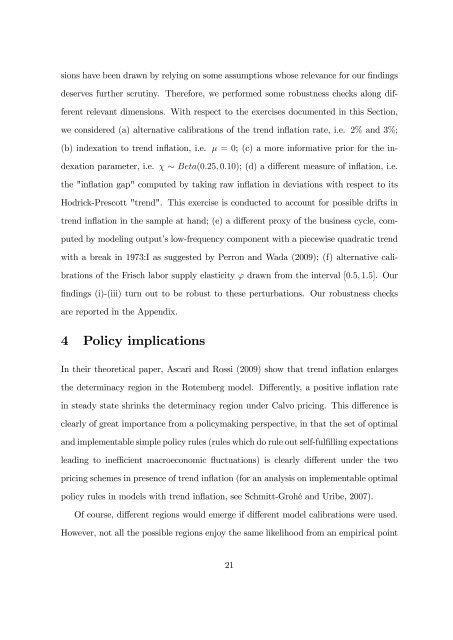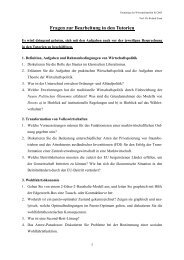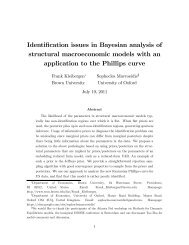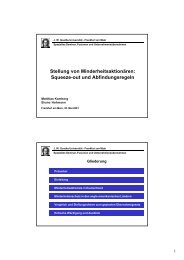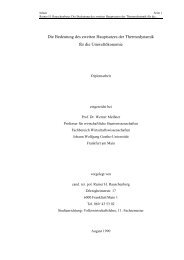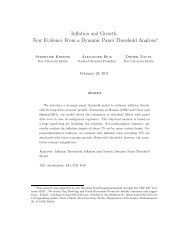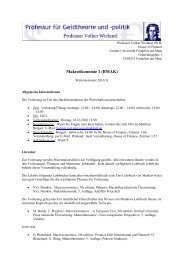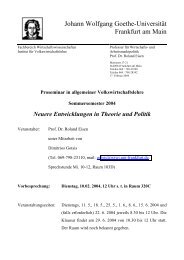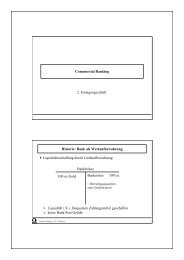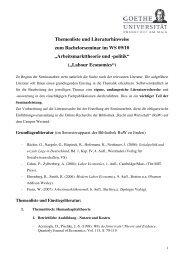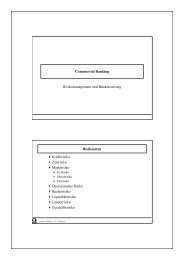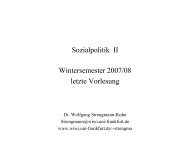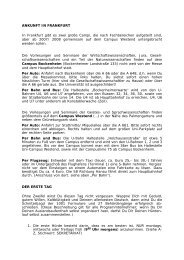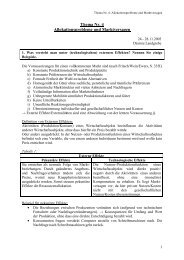Calvo vs. Rotemberg in a Trend Inflation World - Wiwi Uni-Frankfurt
Calvo vs. Rotemberg in a Trend Inflation World - Wiwi Uni-Frankfurt
Calvo vs. Rotemberg in a Trend Inflation World - Wiwi Uni-Frankfurt
You also want an ePaper? Increase the reach of your titles
YUMPU automatically turns print PDFs into web optimized ePapers that Google loves.
sions have been drawn by rely<strong>in</strong>g on some assumptions whose relevance for our …nd<strong>in</strong>gs<br />
deserves further scrut<strong>in</strong>y. Therefore, we performed some robustness checks along dif-<br />
ferent relevant dimensions. With respect to the exercises documented <strong>in</strong> this Section,<br />
we considered (a) alternative calibrations of the trend <strong>in</strong>‡ation rate, i.e. 2% and 3%;<br />
(b) <strong>in</strong>dexation to trend <strong>in</strong>‡ation, i.e. = 0; (c) a more <strong>in</strong>formative prior for the <strong>in</strong>-<br />
dexation parameter, i.e. Beta(0:25; 0:10); (d) a di¤erent measure of <strong>in</strong>‡ation, i.e.<br />
the "<strong>in</strong>‡ation gap" computed by tak<strong>in</strong>g raw <strong>in</strong>‡ation <strong>in</strong> deviations with respect to its<br />
Hodrick-Prescott "trend". This exercise is conducted to account for possible drifts <strong>in</strong><br />
trend <strong>in</strong>‡ation <strong>in</strong> the sample at hand; (e) a di¤erent proxy of the bus<strong>in</strong>ess cycle, com-<br />
puted by model<strong>in</strong>g output’s low-frequency component with a piecewise quadratic trend<br />
with a break <strong>in</strong> 1973:I as suggested by Perron and Wada (2009); (f) alternative cali-<br />
brations of the Frisch labor supply elasticity ' drawn from the <strong>in</strong>terval [0:5; 1:5]. Our<br />
…nd<strong>in</strong>gs (i)-(iii) turn out to be robust to these perturbations. Our robustness checks<br />
are reported <strong>in</strong> the Appendix.<br />
4 Policy implications<br />
In their theoretical paper, Ascari and Rossi (2009) show that trend <strong>in</strong>‡ation enlarges<br />
the determ<strong>in</strong>acy region <strong>in</strong> the <strong>Rotemberg</strong> model. Di¤erently, a positive <strong>in</strong>‡ation rate<br />
<strong>in</strong> steady state shr<strong>in</strong>ks the determ<strong>in</strong>acy region under <strong>Calvo</strong> pric<strong>in</strong>g. This di¤erence is<br />
clearly of great importance from a policymak<strong>in</strong>g perspective, <strong>in</strong> that the set of optimal<br />
and implementable simple policy rules (rules which do rule out self-ful…ll<strong>in</strong>g expectations<br />
lead<strong>in</strong>g to <strong>in</strong>e¢ cient macroeconomic ‡uctuations) is clearly di¤erent under the two<br />
pric<strong>in</strong>g schemes <strong>in</strong> presence of trend <strong>in</strong>‡ation (for an analysis on implementable optimal<br />
policy rules <strong>in</strong> models with trend <strong>in</strong>‡ation, see Schmitt-Grohé and Uribe, 2007).<br />
Of course, di¤erent regions would emerge if di¤erent model calibrations were used.<br />
However, not all the possible regions enjoy the same likelihood from an empirical po<strong>in</strong>t<br />
21


